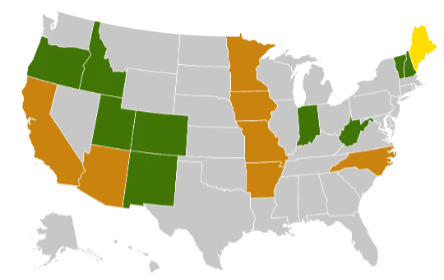November 21, 2023
M&D Clinical Corner: Community Pharmacist’s Guide to Smoking Cessation
The Clinical Corner is a monthly feature that highlights a variety of important pharmacist topics that is written by Morris & Dickson’s staff pharmacist, Paula Belle (RPh).
This month’s Clinical Corner will offer community pharmacists information about Smoking Cessation.
GENERAL INFORMATION
- The Great American Smokeout provides a platform for individuals, communities, and organizations to converge efforts in the fight against tobacco addiction.
- In 2023, The Great American Smokeout will take place on November 21, 2023.
- This month’s Clinical Corner will address ways for community pharmacists to assist patients with smoking cessation:
- Fast Facts
- The Pharmacist’s Role
- Medication Strategies for Smoking Cessation
- Tobacco Cessation Interventions in Community Pharmacies
- Sustainability of Smoking Cessation Programs in Community Pharmacies
- Resources for Pharmacists
FAST FACTS
- Smoking leads to disease and disability and harms nearly every organ of the body. [1]
- Cigarette smoking remains the leading cause of preventable disease, disability, and death in the United States. [1]
- In 2021, 11.5% of U.S. adults (an estimated 28.3 million people) currently smoked cigarettes: 13.1% of men, 10.1% of women. [1]
- Each day, about 1,600 youth try their first cigarette. [1]
THE PHARMACIST’S ROLE
- Healthcare professionals from all fields can play a role in helping patients quit. [2]
- Most U.S. adults who smoke report wanting to quit, and while there are evidence-based treatments that can help, these treatments are largely underutilized. [2]
- Healthcare professionals from all specialties and across disciplines and care settings are needed to help make further progress in addressing the tobacco epidemic and to ensure that everyone who uses tobacco has access to – and is provided with – quality, evidence-based cessation treatment. [2]
- Pharmacists, and other health care professionals can make a positive impact by encouraging smoking cessation. [3]
- Smoking cessation reduces the risk of premature death, and can add approximately 10 years to life expectancy. [3]
- Smoking cessation reduces the risk of adverse health complications including reproductive health issues, cardiovascular diseases, chronic obstructive pulmonary disease, and cancer. [3]
MEDICATION STRATEGIES FOR SMOKING CESSATION
- Current evidence-based treatment approaches to smoking cessation include several behavioral treatments—such as individual, group, and telephone counseling—and seven pharmacotherapies approved by the U.S. Food and Drug Administration (FDA). [4]
- The seven medications approved by the FDA work in different ways. All have been shown to be safe and effective for adults who smoke cigarettes. [5]
- These quit-smoking medicines include nicotine replacement medicines (the nicotine patch, lozenge, gum, oral inhaler, and nasal spray) and pill medicines (varenicline and bupropion SR). [5]
- To view a pharmacological product guide provided by the University of California at San Francisco, double click on the chart below:

FDA Approved Tobacco Cessation Products
- Nicotine Replacement Therapy (NRT)
- NRT works by replacing some of the nicotine patients were getting from cigarettes. [6]
- NRT supplies nicotine without the hundreds of harmful chemicals that cigarette smoke contains. [6]
- Three forms of NRT—the patch, gum, and the lozenge—are available without a prescription from a health care provider. [7]
- The other two forms of NRT (the inhaler and the nasal spray), as well as the two non-NRT medications, are available by prescription only. [7]
- The patch is available both by prescription and over the counter. [7]
- Using the long-acting patch at the same time as a short-acting NRT, like the lozenge or gum, can help decrease withdrawal even more. [6]
- Patients can gradually decrease the amount of nicotine that they take in from NRT over several weeks. [6]
- Non-Nicotine Replacement Therapies (NNRT)
- There are two quit-smoking medicines approved by the U.S. Food and Drug Administration that are pills: bupropion and varenicline. [6]
- Bupropion has many effects on the brain, including helping people quit smoking. It decreases craving and other nicotine withdrawal symptoms. [6]
- Varenicline has two main effects [6]:
- It mimics some of the effects that nicotine has on parts of your brain, reducing your urge to smoke and some withdrawal symptoms. [6]
- It reduces the enjoyment you get from the nicotine in cigarettes. [6]
- It does this by attaching strongly to the same parts of your brain that nicotine attaches to, but without stimulating them as strongly as nicotine. [6]
- This means that nicotine from a cigarette has fewer places to attach because the varenicline is already there. In other words, varenicline makes it harder to get a nicotine “buzz.” [6]
- Pharmacist Prescribing of Tobacco Cessation Medications
- As of 2021, there were 17 states with statutes or regulations addressing pharmacist prescribing of tobacco cessation aids (without a CPA). [8]
- The National Alliance of State Pharmacy Associations (NASPA) provides a tobacco cessation prescribing map for pharmacists. It is available below and at: https://naspa.us/blog/resource/tobacco-cessation/
- Tobacco Cessation Prescribing Map

- Source: NASPA
- Oregon, Idaho, Utah, Colorado, New Mexico, Illinois, West Virginia, Vermont, and New Hampshire allow pharmacists to prescribe all FDA-approved tobacco cessation aids (including varenicline and bupropion.) [8]
- California, Arizona, Minnesota, Iowa, Missouri, Arkansas, and North Carolina allow pharmacists to prescribe all FDA-approved nicotine replacement products. [8]
- Pharmacists should contact their state board of pharmacy to learn specific requirements for prescribing tobacco cessation therapies in their state. [9]
TOBACCO CESSATION INTERVENTIONS IN COMMUNITY PHARMACIES
- Community-based pharmacy tobacco cessation interventions are typically designed to utilize either of two main approaches to care: Ask-Advise-Assess-Assist-Arrange (the 5 A’s) or Ask–Advise–Refer (AAR). [9]
- The brief nature of the AAR model (fewer than 3 minutes) makes this approach acceptable and feasible for integration into the existing community pharmacy workflow. [9]
- With a small amount of training, any pharmacy team member can deliver all three steps of the AAR model. [9]
- In the AAR model a pharmacy team member [9] :
- Asks patients whether they use tobacco products
- Advises patients who use tobacco of the associated health risks, and preliminarily assesses about their readiness to quit
- Refers interested patients to resources that will assist in quitting, such as state or national tobacco quitlines
- The American Lung Association offers a Quick Reference Guide to the Ask-Advise-Refer (AAR) approach.
- Double click here or on the document to view.
SUSTAINABILITY OF SMOKING CESSATION PROGRAMS IN COMMUNITY PHARMACIES
- For tobacco cessation services to be a long-term focus within community-based pharmacy practice, revenue models should support the time that the pharmacy team will spend delivering the services. [9]
- State Medicaid programs, private health plans (e.g., self-insured employers), and patients paying cash are the primary payers for tobacco cessation services. [9]
- For example, Pennsylvania Medicaid allows pharmacies to register in their Medical Assistance program to be eligible to provide and receive payment for tobacco cessation counseling services. [9]
- In 2017, Pennsylvania Medicaid plans paid $19.33 per visit for up to 70 face-to-face, 15-minute counseling sessions per patient per year. [9]
- Payment models like those provided through Pennsylvania Medicaid can facilitate implementation and sustainability of community-based pharmacy tobacco cessation programs. [9]
- Pharmacists should contact their state public health departments to determine if their state has similar funding for programs. [9]
- Another factor that can fuel sustainability of tobacco cessation services is based on increased prescription or OTC sales of tobacco cessation therapies and the potential to increase immunization delivery. [9]
- As tobacco cessation counseling occurs, patients will be more likely to purchase tobacco cessation therapies and may choose to purchase them at the pharmacy where cessation counseling occurs. [9]
- Additionally, once tobacco use status is known, the pharmacist will be able to make pneumococcal vaccine recommendations based on this information, which could increase vaccination delivery in the pharmacy. [9]
- Increased revenue from these services may be a way to potentially offset the costs of providing tobacco cessation services. [9]
RESOURCES FOR PHARMACISTS
- Downloadable resources to promote the Great American Smokeout are available at : Downloadable Resources Great American Smokeout
- A guide that provides simple steps and suggested language that pharmacists can use to briefly intervene with patients who use tobacco is available at: Tobacco Cessation Intervention Steps and Suggested Language
- Million Hearts® template which will allow pharmacists to create a tobacco cessation protocol (based on the most recent clinical guidelines for treating tobacco use and dependence) is available at: Million Hearts® Tobacco Cessation Protocol
- A companion guide to the Million Hearts® tobacco treatment protocol that contains practical information and action steps to enable pharmacists to effectively treat tobacco use and dependence is available at: Million Hearts® Tobacco Cessation Action Guide
- To find out more about state and federal funding for tobacco control programs in each state visit: Funding for Tobacco Cessation Programs
- The University of California at San Francisco provides a comprehensive tobacco cessation training program that equips health professional students and practicing clinicians, of all disciplines, with evidence-based knowledge and skills for assisting patients with quitting. Access the website at: UCSF Tobacco Cessation Training Program
SOURCES
- Centers for Disease Control and Prevention. Fast Facts and Fact Sheets | Smoking and Tobacco Use | CDC. 2023 2023-05-03T07:24:22Z; Available from: https://www.cdc.gov/tobacco/data_statistics/fact_sheets/fast_facts/index.htm.
- Centers for Disease Control and Prevention. Patient Care Settings and Smoking Cessation | Smoking and Tobacco Use | CDC. 2023 2023-03-24T05:44:08Z [cited 2023; Available from: https://www.cdc.gov/tobacco/patient-care/care-settings/index.html.
- Gersham, J. New Report Emphasizes Pharmacist’s Role in Smoking Cessation. 2023 [cited 2023; Available from: https://www.pharmacytimes.com/view/new-report-emphasizes-pharmacists-role-in-smoking-cessation.
- U.S. Department of Health and Human Services, Smoking Cessation. A Report of the Surgeon General., U.S. Department of Health and Human Services, N.C.f.C.D. Centers for Disease Control and Prevention, and O.o.S.a.H. Prevention and Health Promotion, Editors. 2020.
- Centers for Disease Control and Prevention. Quit Smoking Medicines | Quit Smoking | Tips From Former Smokers | CDC. 2023 2023-08-21T09:38:59Z [cited 2023 October]; Available from: https://www.cdc.gov/tobacco/campaign/tips/quit-smoking/quit-smoking-medications/how-to-use-quit-smoking-medicines/index.html.
- Centers for Disease Control and Prevention. How Quit Smoking Medicines Work | Quit Smoking | Tips From Former Smokers | CDC. 2023 2023-07-13T12:00:23Z [cited 2023 October]; Available from: https://www.cdc.gov/tobacco/campaign/tips/quit-smoking/quit-smoking-medications/how-quit-smoking-medicines-work/index.html.
- Centers for Disease Control and Prevention. Coverage for Tobacco Use Cessation Treatments | CDC. 2021 2021-06-02T07:59:04Z [cited 2023 October]; Available from: https://www.cdc.gov/tobacco/quit_smoking/cessation/coverage/index.htm.
- National Alliance of State Pharmacy Associations. Pharmacist Prescribing: Tobacco Cessation Aids – NASPA. 2021 [cited 2023 October]; Available from: https://naspa.us/blog/resource/tobacco-cessation/.
- American Pharmacists Association. Practice Guidance for Expanding Pharmacy-Based Tobacco Cessation Services Within the Appointment-Based Model. 2018 [cited 2023 October]; Available from: https://www.pharmacist.com/ABM/resources.




